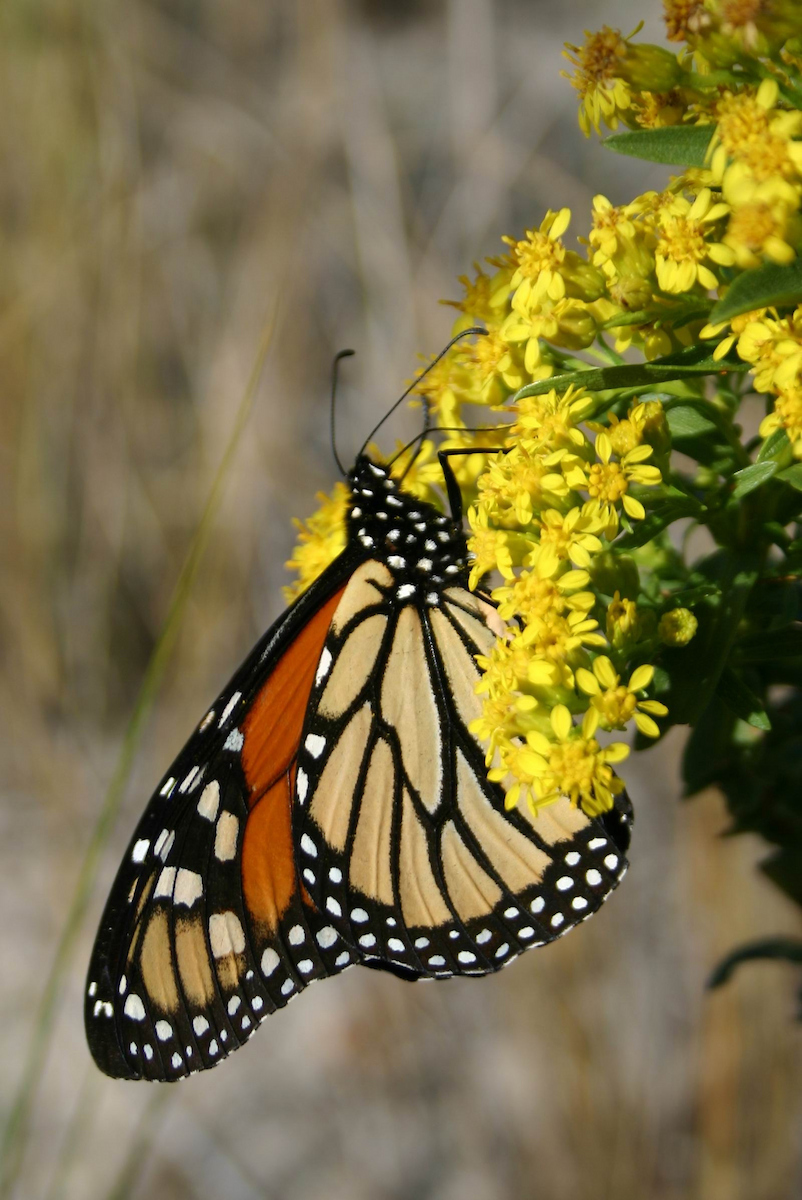DNREC Hosts Parks for Pollinators with Projects to Save Crops and Gardens

The Monarch butterfly is one of the diminishing species that helps to pollinate crops and gardens worldwide.
The Department of Natural Resources and Environmental Control is sharing tips to save pollinators ¬ – the bats, insects, birds and other animals responsible for roughly one of every three bites of food eaten across the world.
The DNREC Division of Parks and Recreation is participating in “Parks for Pollinators,” a national campaign focused on raising awareness about the current pollinator crisis through programs in 35 states. It will feature events at several state parks and the Brandywine Zoo and includes tips people can use at home.
About 75% of flowering plants and 35% of crops rely on pollinators – those agents who move pollen from one part of a plant to another to allow fertilization – to grow their harvests. But some are quickly disappearing. A total of 70 species of insects is listed as endangered or threatened, according to the U.S. Fish and Wildlife Service. A 2023 study published in Current Biology found a 62.5% reduction in the abundance of bees and a 57.6% decline in the abundance of butterflies in relatively undisturbed forested locations in southeastern United States between 2007 and 2022, and up to 2% of the insect population is lost annually, according to a 2021 article in the Proceedings of the National Academy of Sciences of the United States of America.
While bees are primarily thought of as pollinators, other species play a vital role in the process, including beetles, which pollinate flowering plants, and bats, an important nighttime pollinator for 500 flowers, including species of mango, banana and agave. To see the world’s largest pollinator, the Black and white ruffed lemur, the primary pollinator of the Traveler’s palm, visit the Brandywine Zoo.
“There are ways to reverse these trends, and our state parks are offering programs to raise awareness and demonstrate how to save the wide range of pollinators,” said Matthew Ritter, director of DNREC Division of Parks and Recreation. “In addition to our great programs, our team has been actively expanding plantings through parks including multiple pollinator gardens.”
Be on the lookout for all pollinator programs at Delaware State Parks at the Upcoming Events webpage, but below are a few of the highlights:
Bellevue State Park
The Magic of Monarch Migration
Sept. 27, 1 – 2 p.m.
Brandywine Zoo
Fall Moth Ball
Sept. 7, 7:30 – 8:30 pm
Spanish Storytime Series
Sept. 8, 10 a.m. – 3 p.m.
Mighty Monarch Day
Sept. 27, 10 a.m. – 3 pm
Fort Delaware State Park
Pollinator Bioblitz at Pea Patch Island
Sept. 13, 10 a.m. – 2 pm
Holt’s Landing State Park
Bioblitz
Sept. 2, 9, 16, 23, 30; 10 -11:30 a.m.
Lums Pond State Park
Monarch Monitoring Project
Sept. 18, 5:30 – 6:30 pm
Sept. 27. 1- 2 pm
White Clay Creek State Park
Pollinator Program
Sept. 7, 10 – 11 a.m.
DNREC and the Division of Parks and Recreation also developed a toolkit to help educate the public about ways to save pollinators. Among the tips offered are:
• Planting a pollinator garden with native plants that bloom from spring to fall from the Outdoor Delaware online magazine.
• Avoiding the use of harsh insecticides, herbicides and other chemicals by trying natural garden sprays or integrated pest management techniques.
• Providing other resources for pollinators like shelter, water and food.
• Participating in the iNaturalist Program, a platform to record information on important species, share and discuss your observations of nature and contribute to biodiversity science at all Delaware State Parks and the Brandywine Zoo.
• Contributing to the Monarch Larva Monitoring Project by collecting and reporting on larva to help study the distribution and abundances of the population.
For all fall events at Delaware state parks, visit www.destateparks.com.
About DNREC
The Delaware Department of Natural Resources and Environmental Control protects and manages the state’s natural resources, protects public health, provides outdoor recreational opportunities and educates Delawareans about the environment. The DNREC Division of Parks and Recreation oversees more than 26,000 acres in 17 state parks and the Brandywine Zoo and the Indian River Marina. For more information, visit the website and connect with @DelawareDNREC on YouTube, Facebook, Instagram, X (formerly known as Twitter) or LinkedIn.
Media contact: Beth Kuhles-Heiney, elizabeth.kuhlesheiney@delaware.gov; Michael Globetti, michael.globetti@delaware.gov
###
Legal Disclaimer:
EIN Presswire provides this news content "as is" without warranty of any kind. We do not accept any responsibility or liability for the accuracy, content, images, videos, licenses, completeness, legality, or reliability of the information contained in this article. If you have any complaints or copyright issues related to this article, kindly contact the author above.
